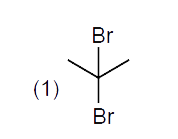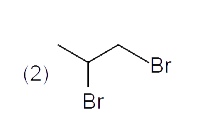1−Methylethylene oxideexcess−−→HBrX, Product 'X' will be-



The correct Answer is:B
To solve the problem of determining the product 'X' formed when methyl ethylene oxide is treated with excess HBr, we can follow these steps:
Step 1: Identify the Structure of Methyl Ethylene Oxide
Methyl ethylene oxide is a cyclic ether with a three-membered ring structure. It can be represented as follows:
OCH3CH2
Step 2: Understand the Reaction with HBr
When methyl ethylene oxide reacts with excess HBr, the first step involves the protonation of the ether oxygen atom. HBr dissociates into H⁺ and Br⁻ ions. The lone pair of electrons on the oxygen atom attacks the H⁺ ion, leading to the formation of a positively charged intermediate.
Step 3: Formation of the Bromonium Ion
After the protonation, the structure becomes:
OH2⁺
/ \
CH3 CH2
This is a bromonium ion intermediate, where the oxygen is now positively charged.
Step 4: Nucleophilic Attack by Bromide Ion
In the presence of excess HBr, the Br⁻ ion will attack the more substituted carbon atom (the one attached to the methyl group) of the bromonium ion. This results in the opening of the ring and the formation of a bromoalcohol.
Step 5: Final Product Structure
The final product 'X' can be represented as follows:
BrCH3−CH−OH
This structure indicates that we have a bromo group (Br) and a hydroxyl group (OH) attached to the same carbon atom, which is a result of the nucleophilic attack by Br⁻.
Conclusion
The product 'X' formed from the reaction of methyl ethylene oxide with excess HBr is 1-bromo-2-methanol.
---
Methyl ethylene oxide is a cyclic ether with a three-membered ring structure. It can be represented as follows:
When methyl ethylene oxide reacts with excess HBr, the first step involves the protonation of the ether oxygen atom. HBr dissociates into H⁺ and Br⁻ ions. The lone pair of electrons on the oxygen atom attacks the H⁺ ion, leading to the formation of a positively charged intermediate.
After the protonation, the structure becomes:
OH2⁺
/ \
CH3 CH2
In the presence of excess HBr, the Br⁻ ion will attack the more substituted carbon atom (the one attached to the methyl group) of the bromonium ion. This results in the opening of the ring and the formation of a bromoalcohol.
The final product 'X' can be represented as follows:
The product 'X' formed from the reaction of methyl ethylene oxide with excess HBr is 1-bromo-2-methanol.
Topper's Solved these Questions
Similar Questions
Knowledge Check
CHO| CHONaOH−−−→X
The product (X) will beA CH2ONa| COONaB COOH| COOHC CH2OH| COONaD CH2OH| CH2OHcis-2-buteneHBr−−−−−→Peroxide product , Product of the reaction is :
ARacemicBDiastereomersCMesoDE and Z isomerIn the given reaction CH3−CH2−NH−CH2−CH2−Cl(i)CH3I(excess)−−−−−−−−−−−−−→(ii)AgOH/Δ[X] is the major product, [X] will be:
ACH2=CH2BCH2=CHCIC1:1 ratio of (a) and (b)DCH3−CH2−CI
NaOH+(solid)CO200∘C−−−→X, product X is :
View SolutionEthylester CH3CH2MgBr−−−−−−−−→excessP. The product P will be
View SolutionCH3−CH3∣CH∣CH3KmnO4−−−−→(A)H+−−→Δ(B)HBr−−−→ROOR(C)
Product (C) in the above reactions is :
View SolutionMn+(aq.)+KI→X↓ppt.Excess−−−→KI ppt. remains insoluble in excess KI solution. Then cation Mn+(aq.) can be:
View SolutionThe integral 5∫1x2dx is equal to
View Solution

